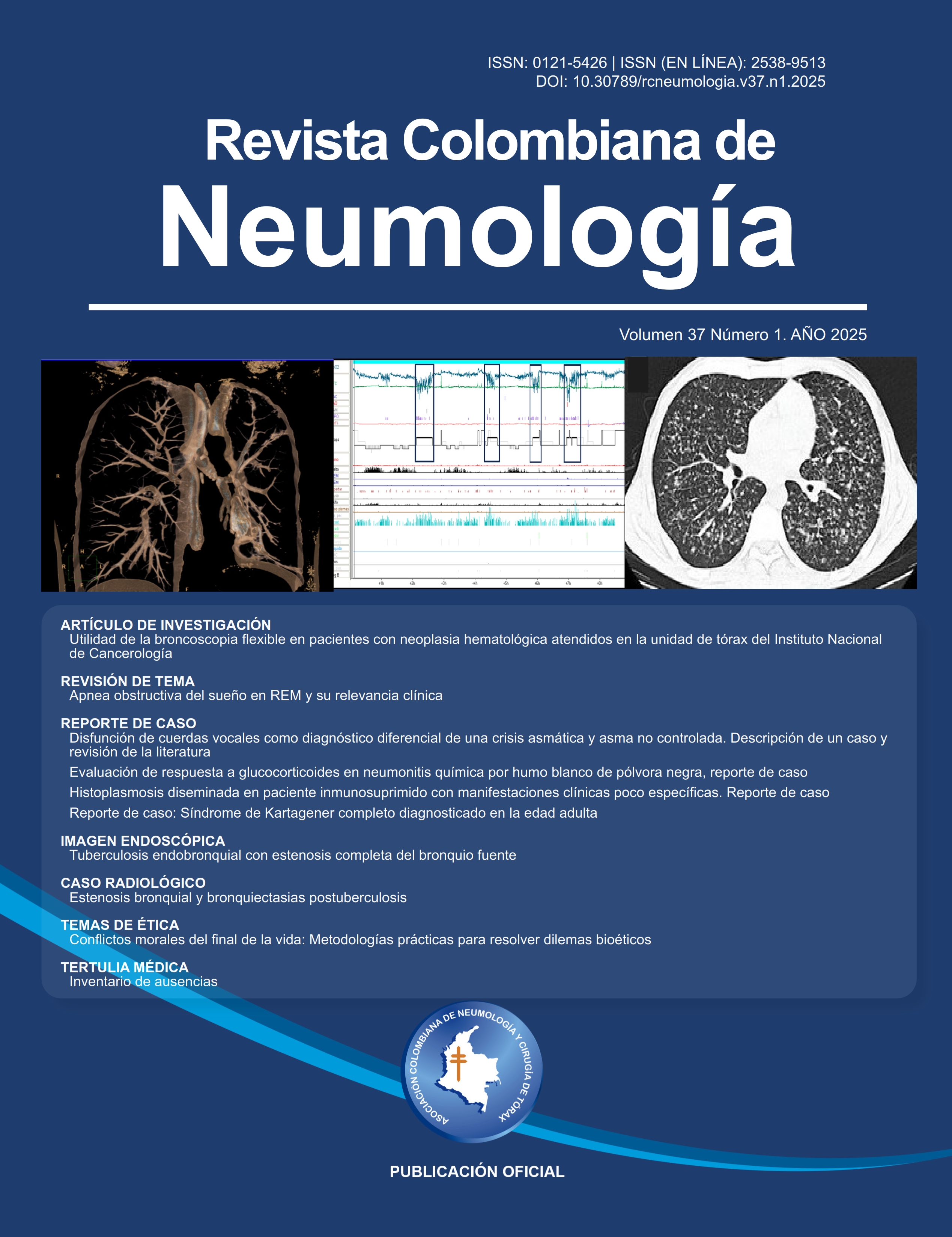Vocal cord dysfunction as a differential diagnosis of an asthma exacerbation and uncontrolled asthma. A case report and review of the literature
Disfunción de cuerdas vocales como diagnóstico diferencial de una crisis asmática y asma no controlada. Descripción de un caso y revisión de la literatura

This work is licensed under a Creative Commons Attribution-NonCommercial-ShareAlike 4.0 International License.
Ninguna publicación, nacional o extranjera, podrá reproducir ni traducir sus artículos ni sus resúmenes sin previa autorización escrita del editor; sin embargo los usuarios pueden descargar la información contenida en ella, pero deben darle atribución o reconocimiento de propiedad intelectual, deben usarlo tal como está, sin derivación alguna.
Show authors biography
Vocal fold dysfunction (VCD) is a pathology characterized by paroxysmal and involuntary episodes of adduction of the vocal folds during inspiration. In severe cases, it obstructs the central airway, causing dyspnea and stridor. This disorder is related to multiple etiologies, such as neurological disorders, gastroesophageal reflux, psychogenic disorders, allergic rhinitis, and asthma, among others.
VCD occurs in women between 20 and 45 years of age. However, it also includes preschool children, schoolchildren, and adults. Laryngeal dysfunction can be confused with asthma, acute respiratory disorders, or laryngeal problems. The diagnosis is usually made after excluding other pathologies by performing forced spirometry and direct vision of the paradoxical movement of the vocal folds during inspiration by fiberoptic bronchoscopy (FBC).
We present the case of a patient who consulted because of cough, dyspnea, and wheezing refractory to bronchodilator management, where the studies carried out helped to rule out infectious/bronchial obstructive pathology and showed the diagnosis of VCD.
Article visits 322 | PDF visits 153
Downloads
- Christopher KL WRER et al. Vocal - cord dysfunction presenting as asthma. N Engl J Med. 1983;26:1566–70. DOI: https://doi.org/10.1056/NEJM198306303082605
- Leong P, Vertigan AE, Hew M, Baxter M, Phyland D, Hull JH, et al. Diagnosis of vocal cord dysfunction/inducible laryngeal obstruction: an International Delphi Consensus Study. Journal of Allergy and Clinical Immunology. 2023 Oct 1;152(4):899-906. doi: 10.1016/j.jaci.2023.06.007. DOI: https://doi.org/10.1016/j.jaci.2023.06.007
- Newman KB, Mason UG, Schmaling KB. Brief Communications Clinical Features of Vocal Cord Dysfunction. 1995 Oct;152(4Pt1):1382-6. doi: 10.1164/ajrccm.152.4.7551399. DOI: https://doi.org/10.1164/ajrccm.152.4.7551399
- Petrov AA. Vocal Cord Dysfunction: The Spectrum Across the Ages. Immunology and Allergy Clinics of North America. 2019 Nov;39(4):547-560. doi: 10.1016/j.iac.2019.07.008. DOI: https://doi.org/10.1016/j.iac.2019.07.008
- Traister RS, Fajt ML, Whitman-Purves E, Anderson WC, Petrov AA. A retrospective analysis comparing subjects with isolated and coexistent vocal cord dysfunction and asthma. Allergy Asthma Proc. 2013 Jul;34(4):349–55. doi: 10.2500/aap.2013.34.3673. DOI: https://doi.org/10.2500/aap.2013.34.3673
- Christensen PM, Heimdal JH, Christopher KL, Bucca C, Cantarella G, Friedrich G, et al. ERS/ELS/ACCP 2013 International consensus conference nomenclature on inducible laryngeal obstructions. European Respiratory Review. European Respiratory Society. 2015 24: 445-450. doi: 10.1183/16000617.00006513. DOI: https://doi.org/10.1183/16000617.00006513
- Cohen SM. The Journal for Nurse Practitioners-JNP 675 Diagnosis and Management of Vocal Cord Dysfunction [Internet]. 2010. Available from: www.npjournal.org. doi: 10.1016/j.nurpra.2010.04.004. DOI: https://doi.org/10.1016/j.nurpra.2010.04.004
- Forrest LA, Husein T, Husein O. Paradoxical vocal cord motion: Classification and treatment. Laryngoscope. 2012 Apr;122(4):844–53. doi: 10.1002/lary.23176. DOI: https://doi.org/10.1002/lary.23176
- Chacón A. R, González J. L, Montalbán R C. Manejo de la vía aérea en procedimientos de vía aérea superior. Rev Chil Anest [Internet]. el 27 de marzo de 2010;39(2):141–51. Disponible en: https://revistachilenadeanestesia.cl/manejo-de-la-via-aerea-en-procedimientos-de-via-aerea-superior/
- Kaminsky DA, Simpson SJ, Berger KI, Calverley P, de Melo PL, Dandurand R, et al. Clinical significance and applications of oscillometry. European Respiratory Review. European Respiratory Society; 2022; 31: 210208. doi: 10.1183/16000617.0208-2021. DOI: https://doi.org/10.1183/16000617.0208-2021
- Díaz Santos, MD. G, Hincapié, MD. GA, Ordóñez, MD. J, Awad, MD. C. Oscilometría de impulso en adultos: una prueba de función pulmonar complementaria. Rev Colomb Neumol. 2014;26(2). doi: https://doi.org/10.30789/rcneumologia.v26.n2.2014.46 DOI: https://doi.org/10.30789/rcneumologia.v26.n2.2014.46
- Hira HS, Singh A. Significance of upper airway influence among patients of vocal cord dysfunction for its diagnosis: Role of impulse oscillometry [Internet]. Lung India. 2009 Jan;26(1):5-8. doi: 10.4103/0970-2113.45197. DOI: https://doi.org/10.4103/0970-2113.45197
- Bisdorff B, Kenn K, Nowak D, Schlichtiger J, Bäuml J, Orban E, et al. Asthma and vocal cord dysfunction related symptoms in the general population - A pilot study. Annals of Allergy, Asthma and Immunology. 2014 Nov 1;113(5):576-7. doi: 10.1016/j.anai.2014.08.009. DOI: https://doi.org/10.1016/j.anai.2014.08.009
- Kramer S, deSilva B, Forrest LA, Matrka L. Does treatment of paradoxical vocal fold movement disorder decrease asthma medication use? Laryngoscope. 2017 Jul 1;127(7):1531-7. doi: 10.1002/lary.26416. DOI: https://doi.org/10.1002/lary.26416
- Baxter M, Ruane L, Phyland D, Leahy E, Heke E, Lau KK, et al. Multidisciplinary team clinic for vocal cord dysfunction directs therapy and significantly reduces healthcare utilization. Respirology. 2019 Aug 1;24(8):758–64. doi: 10.1111/resp.13520. DOI: https://doi.org/10.1111/resp.13520
- Drake K, Palmer AD, Schindler JS, Tilles SA. Functional Outcomes after Behavioral Treatment of Paradoxical Vocal Fold Motion in Adults. Folia Phoniatrica et Logopaedica. 2018 Mar 1;69(4):154–68. doi: 10.1159/000484716. DOI: https://doi.org/10.1159/000484716
- Shaffer M, Litts JK, Nauman E, Haines J. Speech-Language Pathology as a Primary Treatment for Exercise-Induced Laryngeal Obstruction. Immunology and Allergy Clinics of North America. 2018 May;38(2):293-302. doi: 10.1016/j.iac.2018.01.003. DOI: https://doi.org/10.1016/j.iac.2018.01.003
- Ruotsalainen JH, Sellman J, Lehto L, Jauhiainen M, Verbeek JH. Interventions for treating functional dysphonia in adults. Cochrane Database of Systematic Reviews. 2007 Jul 18:(3):CD006373. doi: 10.1002/14651858.CD006373.pub2. DOI: https://doi.org/10.1002/14651858.CD006373
- Casper JK, Murry T. Voice therapy methods in dysphonia. Otolaryngol Clin North Am. 2000 Oct;33(5):983-1002. doi: 10.1016/s0030-6665(05)70259-0. DOI: https://doi.org/10.1016/S0030-6665(05)70259-0







